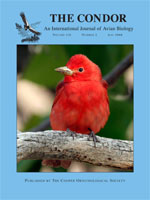Double brooding is the initiation of a second clutch of eggs after successfully raising young from the first clutch. Migratory birds that nest in temperate North America are often single-brooded, but there is widespread intra- and interspecific variation. Tree Swallows (Tachycineta bicolor), which are becoming a model species in biology, are typically classified as a single-brooded species. We documented 18 cases of double brooding in a population of Tree Swallows recently established in the Shenandoah Valley, Virginia. Double brooding may be underreported in this species or may be increasing as a result of climate change or range expansion. If double brooding is as common elsewhere as it was in our study population, it could significantly alter estimates of seasonal or lifetime reproductive success in this widely studied bird.
How to translate text using browser tools
1 May 2008
Occurrence and Implications of Double Brooding in a Southern Population of Tree Swallows
Adrian P. Monroe,
Kelly K. Hallinger,
Rebecka L. Brasso,
Daniel A. Cristol

The Condor
Vol. 110 • No. 2
May 2008
Vol. 110 • No. 2
May 2008
double brooded
double clutching
productivity
Tachycineta bicolor
Tree Swallow




